
The Metro Green Line is an 11-mile (18 km) light rail line that connects the central business districts of Minneapolis and Saint Paul in Minnesota as well as the University of Minnesota. An extension is under construction that will extend the line to the southwest connecting St. Louis Park, Hopkins, Minnetonka and Eden Prairie. The line follows the path of former Metro Transit bus route 16 along University Avenue and Washington Avenue. It is the second light-rail line in the region, after the Blue Line, which opened in 2004 and connects Minneapolis with the southern suburb of Bloomington.

The Light Rail Transit (LRT) is a series of localised automated guideway transit systems acting as feeder services to the heavy rail Mass Rapid Transit, which together forms the core of Singapore's rail transport services. The first LRT line was opened in 1999 and the system has since expanded to three lines, each serving a public housing estate, namely Bukit Panjang LRT line, Sengkang LRT line and Punggol LRT line. Trains on these lines have at least one station interchange link to the MRT.

The Manila Light Rail Transit System, commonly known as the LRT, is an urban rail transit system that primarily serves Metro Manila, Philippines. Although categorized as a light rail system because it originally used light rail vehicles, it presently has characteristics of a rapid transit system, such as high passenger throughput, exclusive right-of-way, and later use of full metro rolling stock. The LRT is jointly-operated by the Light Rail Transit Authority (LRTA), a government corporation attached to the Department of Transportation (DOTr), and the Light Rail Manila Corporation (LRMC). Along with the Manila Metro Rail Transit System and the Metro Commuter Line of the Philippine National Railways, the system makes up Metro Manila's rail infrastructure.

The Kolkata Metro is a rapid transit system serving the city of Kolkata in West Bengal, India. As of January 2023, it has three operational lines, a 31.36 km (19.49 mi) line from Dakshineswar to Kavi Subhash, a 9.1 km (5.7 mi) line from Salt Lake Sector V to Sealdah, and a 6.5 km (4.0 mi) line from Joka to Taratala, for a total of 46.96 km (29.18 mi). Three other lines are in various phases of construction. The system has a mix of underground, at-grade and elevated stations using both broad-gauge and standard-gauge tracks. Trains operate between 06:55 and 22:30 IST and the fares range from ₹5 to ₹25.
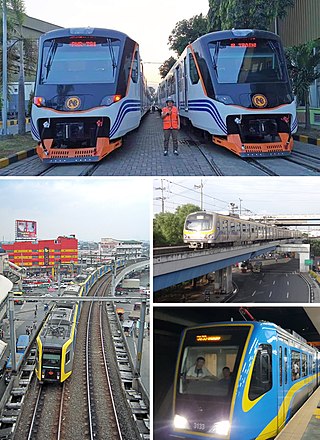
Rail transportation in the Philippines is currently used mostly to transport passengers within Metro Manila and provinces of Laguna and Quezon, as well as a commuter service in the Bicol Region. Freight transport services once operated in the country, but these services were halted. However, there are plans to restore old freight services and build new lines. From a peak of 1,100 kilometers (680 mi), the country currently has a railway footprint of 533.14 kilometers (331.28 mi), of which only 129.85 kilometers (80.69 mi) are operational as of 2023, including all the urban rail lines. World War II, natural calamities, underspending, and neglect have all contributed to the decline of the Philippine railway network. In the 2019 Global Competitiveness Report, the Philippines has the lowest efficiency score among other Asian countries in terms of efficiency of train services, receiving a score of 2.4, and ranking 86th out of 101 countries globally. The government is currently expanding the railway network up to 1,900 kilometers (1,200 mi) by 2022 through numerous projects.

The Macau Light Rapid Transit is a mass transit system in Macau and is also the first railway system in Macau. The first phase of the project started construction in February 2012, and the first section of the Taipa line was opened to the public on 10 December 2019. Currently, the Macau Light Rapid Transit is operated by MTR (Macau), a wholly-owned subsidiary of MTR.

Transit City was a plan for developing public transport in Toronto, Ontario, Canada. It was first proposed and announced on 16 March 2007 by then-Toronto Mayor David Miller and Chair of the Toronto Transit Commission (TTC) Adam Giambrone. The plan called for the construction of seven new light rail lines along the streets of seven priority transit corridors, which would have eventually been integrated with existing rapid transit, streetcar, and bus routes. Other transit improvements outlined in the plan included upgrading and extending the Scarborough RT line, implementing new bus rapid transit lines, and improving frequency and timing of 21 key bus routes. The plan integrated public transportation objectives outlined in the City of Toronto Official Plan, the TTC Ridership Growth Strategy and Miller's 2006 election platform.
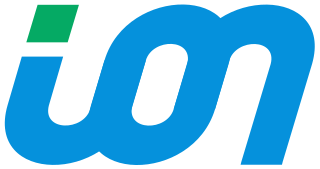
Ion, stylized as ION, is an integrated public transportation network in the Regional Municipality of Waterloo in Ontario, Canada. It is operated by Keolis and is part of the Grand River Transit (GRT) system, partially replacing GRT's Route 200 iXpress bus service. The section of the bus route serving Cambridge has been renamed "Ion Bus", and renumbered as 302. The first phase commenced operations on June 21, 2019, between the north end of Waterloo and the south end of Kitchener. A future extension of light rail to the downtown Galt area of Cambridge is planned but construction may not begin on that line until 2028.

Line 6 Finch West, also known as the Finch West LRT, is a light rail line under construction in Toronto, Ontario, Canada, to be operated by the Toronto Transit Commission. The 10.3-kilometre (6.4 mi), 18-stop line is to extend from Finch West station on Line 1 Yonge–University to the North Campus of Humber College in Etobicoke. Unlike most of the Toronto streetcar system, the line will be segregated from traffic. As well, it will use transit signal priority and standard gauge rather than the broad Toronto gauge. The line is forecast to carry about 14.6 million rides a year or 40,000 a day by 2031 and will replace the 36 Finch West bus route, which is one of the three busiest bus routes in Toronto. The line is scheduled for completion in 2023, with an estimated cost of $2.5 billion.
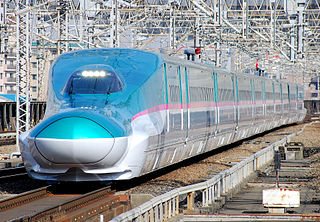
Indian Railways does not have any operational high speed rail lines, though a total of twelve corridors are proposed, with the corridor between Mumbai and Ahmedabad under construction. As of 2022, the highest operational speeds are on the Gatimaan Express with some sections achieving 160 km/h (99 mph), while the fastest train is the Vande Bharat Express with a design top speed of 180 km/h (110 mph),
Chennai Monorail was a proposal for a number of lines as part of mass transit system for the Indian city of Chennai. Originally the city planned to use monorail on all lines but many were subsequently changed to railways as part of the Chennai Metro.
Kolkata Monorail was a rail-based transit project planned for the city of Kolkata, West Bengal, India. This was the first proposed monorail in the country.

Urban rail transit in India plays an important role in intracity transportation in the major cities which are highly populated. It consists of rapid transit, suburban rail, monorail and tram systems. According to a report published in 2021, a total of 2.63 billion people travelled annually in metro systems across India's fifteen major cities, placing the country as one of the busiest urban rapid transit hubs in the world in terms of ridership. The combined length of 822.038 kilometres of metro systems in India makes it the fourth longest in operation in the world.

Netaji Metro Station is a station of the Kolkata Metro. This station is situated opposite to the Kudghat bus stand at Kudghat, in Tollygunge.
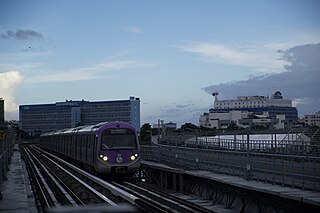
Kolkata Metro Line 2, also known as the East-West Metro and Green Line, is a rapid transit line of the Kolkata Metro in the Indian state of West Bengal. It currently consists of an operational section between Salt Lake and Sealdah, and will eventually connect Howrah by going underneath the Hooghly River, with an eastern extension also planned for Teghoria. It would consist of 17 stations from Teghoria (Haldiram) in the east to Howrah Maidan in the west, of which 11 would be elevated and 6 would be underground, with a total distance of 22 km. It is expected to derive a very high ridership since it will connect India's two largest commuter railway and long-distance railway terminals (Howrah and along with two of its largest business districts. It will also be connecting the industrial hub of Kolkata i.e. Howrah and the IT hub of Kolkata i.e. Sector 5. Line 2 has India's biggest underwater metro tunnel along with the deepest metro shaft. In the deepest metro shaft, Howrah metro station will be the deepest metro station in India, which will be 33 meters deep.The first phase between Salt Lake Sector V and Salt Lake Stadium was inaugurated by Union Railway Minister Piyush Goyal on 13 February 2020 and commercial services started from 14 February 2020.
Kozhikode Metro is a proposed Light Rapid Transit (LRT) system for the city of Kozhikode (Calicut), in India. In 2010, the State government explored the possibility of implementing a metro rail project for Kozhikode city and its suburbs. The proposal was to have a corridor connecting Meenchanda to the Kozhikode Medical College Hospital through the heart of the city. An inception report was submitted by a Bangalore-based consultant, Wilber Smith, on the detailed feasibility study on the prospect of implementing the Mass Rapid Transport System (MRTS) and Light Rail Transit System (LRTS) in the city. However, the project has been scrapped to be replaced by Kozhikode Monorail project. The State Cabinet then decided to form a special purpose vehicle (SPV) to implement monorail projects in Kozhikode and Thiruvananthapuram, and administrative sanction was given in October 2012. The state government issued orders entrusting the Thiruvananthapuram Monorail project to the KMCL on 26 November 2012. The government had handed over the Kozhikode Monorail project to the KMCL prior to that. On 12 June 2013, the State Cabinet gave clearance for an agreement to be signed between KMCL and DMRC, that would make the latter the general consultant for the monorail projects in Kozhikode and Thiruvananthapuram. The DMRC will receive a consultancy fee of 3.25% of the ₹ 55.81 billion. The agreement was signed on 19 June 2013. However, due to cost overrun and the cold response from the bidders the project was put on hold. Bombardier Transportation was the only bidder for the project. The project was later scrapped and Light metro was proposed.
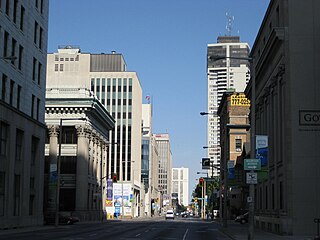
The Hamilton LRT is a planned light rail line in Hamilton, Ontario, Canada, to operate along Main Street, King Street, and Queenston Road. It is one of five planned rapid transit lines which form Hamilton's proposed BLAST network. The 14 km (8.7 mi), 17-stop route is planned to extend from McMaster University to Eastgate Square via downtown Hamilton.

The BLAST network is a plan for a frequent rapid transit system in the city of Hamilton, Ontario, Canada. It was conceived as part of the city's 2007 transportation master plan. It was later incorporated by Metrolinx as part of its regional transportation plan, The Big Move. The B-Line LRT and A-Line are among the plan's prioritized transit expansion projects and were funded by the Government of Ontario in May 2015.
The Guwahati Metro is a rapid transit proposed for the city of Guwahati, Assam, India. The system plan consists of 4 corridors covering a distance of 61.42 km in phase one of the Guwahati Metro.
The Baranagar to Barrackpore, 12.50 km metro corridor in North 24 Parganas, is another line of Kolkata Metro, was sanctioned in 2009, at a cost of Rs.2070 crore, to enable a quicker commute from the northern suburbs to Kolkata, via North Kolkata.

















